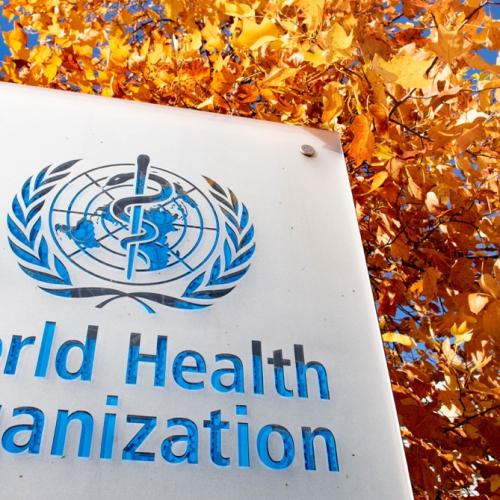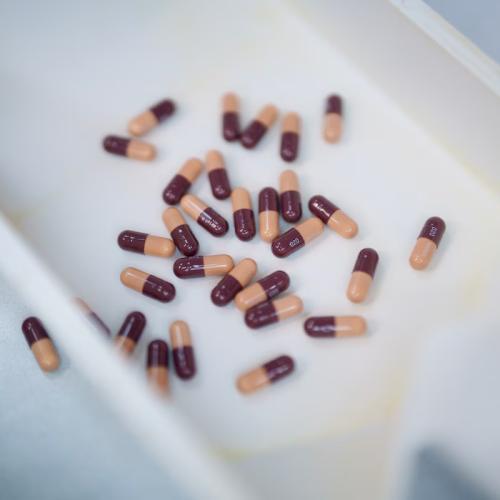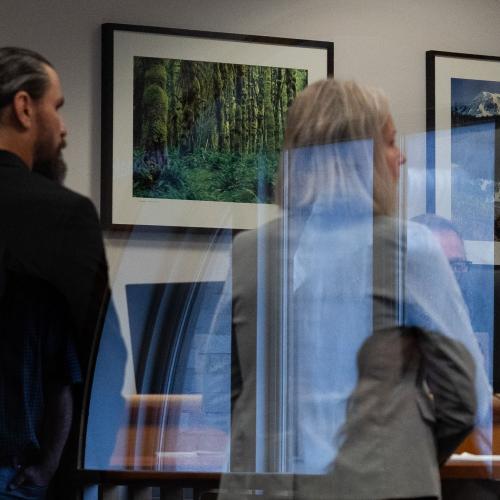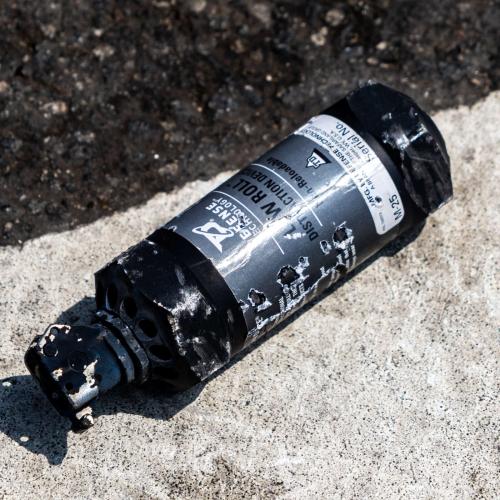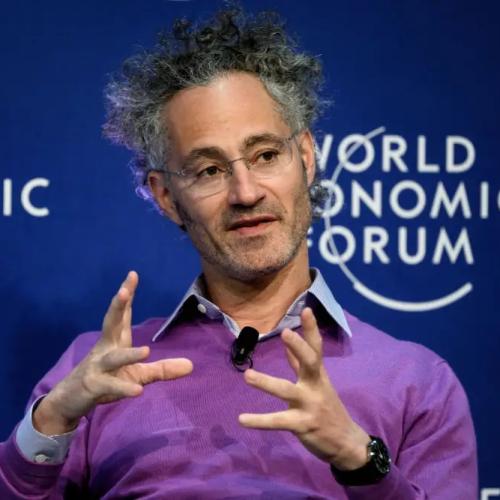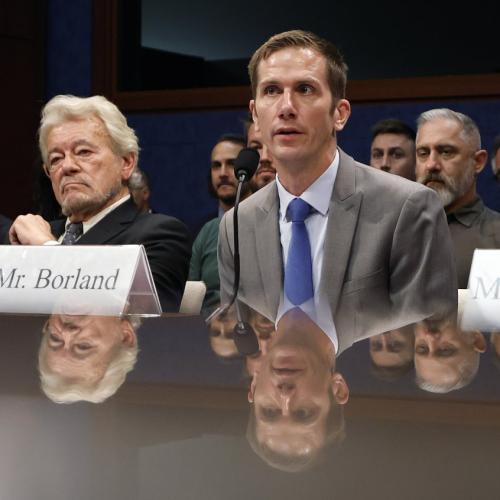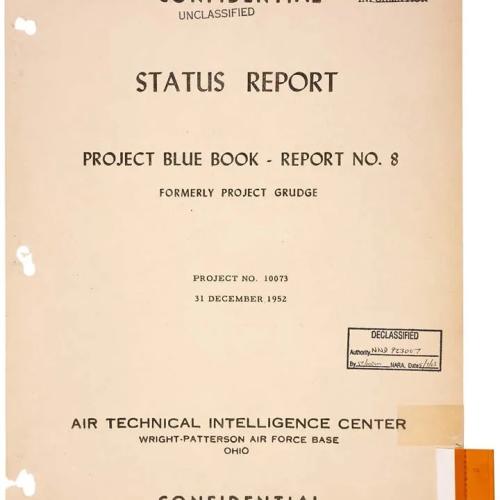News StoriesExcerpts of Key News Stories in Major Media
Below are key excerpts of revealing news articles from reliable news media sources. If any link fails to function, a paywall blocks full access, or the article is no longer available, try these digital tools.
For further exploration, delve into our comprehensive Information Centers.
If you’ve been on social media lately, chances are you’ve heard about endocrine disruptors. People say they can interfere with your hormones, leading to serious health conditions. There are over 1,000 types of these chemicals, according to some estimates, and we are exposed to them daily: They can be found everywhere from your nonstick pan and canned foods to your shampoo and hair dye. The endocrine system consists of glands that secrete hormones, like estrogen, testosterone and cortisol, that then interact with targets (receptors) in the body to regulate our growth, development, reproduction, metabolism, energy balance and body weight. Chemicals that interfere with this complex communication system are called endocrine disruptors. These chemicals work in a variety of ways, including overstimulating receptors, blocking receptors so that normal hormones can’t interact with them and altering hormone production or availability. Bisphenol A (BPA) is a chemical used in the production of polycarbonate plastics and epoxy resins. It belongs to the larger class of chemicals called bisphenols. The primary exposure for most people is through their diet: BPAs can leach into food or drinks from the protective, internal epoxy resin coatings of canned foods and from consumer products such as polycarbonate tableware, food storage containers and water bottles. Laboratory experiments ... have found that BPAs may cause cancer cell growth.
Note: For more along these lines, read our concise summaries of news articles on health and toxic chemicals.
A major settlement announced this week brought an end to a lengthy battle between chemical manufacturer Monsanto and students, parents and staff of a Monroe school who were exposed to toxic PCBs for years. PCBs, or polychlorinated biphenyls, are human-made chemicals that the Environmental Protection Agency has linked to some cancers and other illnesses. They festered at Sky Valley Education Center, an alternative school in Snohomish County, where fluorescent lights and building caulking were contaminated. The preservatives were once widely relied upon for building durability, but the EPA has since banned their use. More than 200 people from Sky Valley blamed their serious illnesses on exposure to the toxicant. This week’s announcement marks the largest, and only significant, PCB personal injury settlement since Monsanto was acquired by Bayer Pharmaceuticals in 2018 And it appears to be among the largest, if not the largest, PCB settlement stemming from a single site containing the pollutant. The terms of the settlement, including the dollar amount, are confidential. But in July, before the agreement, Germany-based Bayer informed its investors that it had set aside 530 million euros, or about $618 million, for Sky Valley settlements and litigation costs. Sky Valley students, staff and others ... described devastating diagnoses, including various cancers, brain damage, autoimmune diseases and miscarriages. Some, including children, reportedly died.
Note: For more along these lines, read our concise summaries of news articles on corporate corruption and toxic chemicals.
Children highly exposed to an insecticide prior to birth showed signs of impaired brain development and motor function, according to a new study of chlorpyrifos — a pesticide still used on US crops despite decades of warnings about its impact on children’s health. The study ... is the first to tie prenatal exposure to the pesticide to “enduring and widespread molecular, cellular, and metabolic effects in the brain,” the authors wrote. The study ... comes months after the US Environmental Protection Agency (EPA) announced its plans to partially ban chlorpyrifos but allow continued use on 11 crops. The EPA ... banned chlorpyrifos in 2021 after a federal court ordered the agency to take action amid litigation and a wealth of evidence of the risks it poses to children. But the agency reversed course again after a different federal court sided with farm groups in opposition. MRI scans showed that kids with the highest levels of exposure were more likely to have reduced blood flow to the brain, thickening of the brain cortex, abnormal brain pathways, impaired nerve insulation and other problems. Chlorpyrifos was the 11th most frequently found pesticide in food samples in the most recent Food and Drug Administration (FDA) pesticide residue monitoring report, and a 2023 US Department of Agriculture pesticide residue report found traces of the chemical in baby food made with pears, as well as in samples of blackberries, celery and tomatoes.
Note: For more along these lines, read our concise summaries of news articles on government corruption and toxic chemicals.
French MPs gave themselves a round of applause for approving legislation to reintroduce a banned pesticide last month. A figure rose from the public gallery to shout: “You are supporters of cancer ... and we will make it known.” Fleur Breteau made it known. Her outburst and appearance – she lost her hair during chemotherapy for breast cancer – boosted a petition against the “Duplomb law” to well over 2m signatures. On Thursday, France’s constitutional court struck down the government’s attempt to reintroduce the pesticide acetamiprid – a neonicotinoid banned in France in 2018 but still used as an insecticide in other EU countries as well as the UK – in a judgment that took everyone by surprise. The ruling said the legislature had undermined “the right to live in a balanced and healthy environment” enshrined in France’s environmental charter. For Breteau, 50, a battle is won but the struggle goes on. “The law is a symptom of a sick system that poisons us. The Duplomb law isn’t the real problem. It’s aggravating an already catastrophic system,” she said. “We are living in a toxic world and need a revolution to break the chain of contamination in everything ... If people don’t react we’ll find ourselves in a world where we cannot drink water or eat food that is uncontaminated, where a slice of buttered bread or a cup of tea poisons us. It will be a silent world, without animals, without insects, without birds.”
Note: For more along these lines, read our concise summaries of news articles on health and toxic chemicals.
The transparency of donations to the World Health Organization (WHO) Foundation—an independent body that seeks funds from across industry, civil society and governments, and awards grants to the WHO — has plummeted over its first 3 years of operations, a new analysis has found. The analysis found that the majority of donors are not publicly disclosed, including some unnamed gifts as big as $11 million, which raises concerns about the potential “level of outside influence and role of commercial interests in setting WHO priorities,” the researchers wrote. In 2020, the foundation was set up to solicit funds from a wider range of donors than the WHO can directly accept, including wealthy individuals and corporations. Some academics and civil society organizations are concerned that accepting donations from industry, such as businesses selling alcohol and infant formula, poses a conflict of interest. Evidence suggests that some companies use donations “as opportunities to distract or reframe product harms.., and assist wider lobbying efforts against public health regulation,” wrote the authors of the new analysis. Using a scale to judge transparency in donations developed by Open Democracy, an independent international media platform, the researchers gave the WHO Foundation a D grade. This grade is for organizations that only name a minority of funders and not in a systematic way, putting it on par with some ‘dark money’ think tanks.
Note: Concerns about WHO’s growing dependence on opaque funding are not abstract. Past investigations show how Purdue Pharma influenced WHO opioid guidelines to expand sales globally and how Coca-Cola–linked consultants shaped WHO’s aspartame reviews. Bill Gates’ hundreds of millions to WHO now give him outsized influence to prioritize corporate interests under the guise of public health philanthropy, which have led to mass suicides in India, worsening environmental degradation and poverty in Africa, and increasing corporate control over the media.
As the 2025 USDA Dietary Guidelines for Americans take shape, a serious disconnect threatens public health. Some advocates are calling for higher intake of animal fats and promoting so called ancestral or animal based keto diets, citing traditional wisdom and nutrient density. Diets like Keto often rely on meat and dairy from industrial production systems, where contamination with drugs and chemicals is routine. The promise of healing through meat and fat collapses when those foods carry residues of antibiotics, steroid hormones, synthetic preservatives, arsenicals, cocciodiostats, and pesticides. Many of these toxins accumulate precisely in the fats and organs being celebrated as nutrient rich. A decade ago, as policy director at the Center for Food Safety, I helped publish a report entitled "America's Secret Animal Drug Problem,” identifying over 450 animal drugs and feed additives used in U.S. meat production. That number alarmed me then. Today, the Food and Drug Administration has approved nearly 700 veterinary drugs for use in food-producing animals. This figure includes not only growth promoters and antibiotics but also synthetic hormones, beta agonists, coccidiostats, and antiparasitics. Less than 1% of meat and dairy in the United States is produced in regenerative organic systems on pasture. The remaining 99% comes from animals housed in industrial facilities, fed chemically saturated GMO grains.
Note: For more along these lines, read our concise summaries of news articles on factory farming and toxic chemicals.
While trying to come up with a pesticide solution to kill off bollworms, Dr Robert Mensah had his eureka moment. It was the 90s, and in Australia bollworms were devastating cotton farms. He experimented and eventually came up with a simple food spray, “a mixture of food ingredients, yeast and sugar-based, diluted in water and applied to crops. It emits an odour which is picked up by beneficial predatory insects and attracts them to the fields where they kill pests.” It was the beginning of an international grassroots campaign, in which Mensah has worked with various charities to teach people about this sustainable farming method. Ever since the dangerous side effects of pesticides became widely known, alternatives have been sought. This approach to farming, which reduces our reliance on pesticides, is called integrated pest management. In 2005, Mensah took food sprays to Benin, where the Pesticide Action Network (PAN UK) was helping farmers transition to organic farming. There, the misuse of chemical pesticides was seriously damaging people’s health. The food sprays – cheap, safe and effective – caught on with farmers in Benin where thousands now use the technique. From there, Mensah took food sprays to southern Ethiopia, where they were also trialled successfully on vegetables ... and then to Vietnam where they were used successfully on maize. Another charity, Better Cotton, is now trialling food sprays in India ... where they’ve trained 214,000 farmers to use sprays.
Note: Explore more positive stories like this on technology for good and healing the Earth.
Small was what the couple wanted. Ms. Boyle is from Vermont, and while studying at Emerson College in Boston, she worked an office job connected to the local food movement. But she quickly realized she wanted to be outside with her hands in the earth. Mr. Wolcik graduated from the University of Massachusetts Amherst, where he studied sustainable agriculture and community food systems. He, too, realized he wanted a life close to the soil. They met while working at a nonprofit farm outside Boston and soon discovered they shared a dream about buying their own acreage to grow food and flowers. They weren’t interested in a massive operation. Instead, their vision included no-till growing methods, hand tools, and a desire to build a “human scale” production system. They also wanted to make their living entirely from their farm – something increasingly difficult to do in New England. Over the past 60 years, the region has lost 80% of its farmland. They joined a community actively building a new storyline around farming, food, and resilience in New England. Here, in this part of little Vermont, statewide population 648,000, a coalition of farmers, nonprofits, and residents is eschewing mainstream beliefs about what makes agriculture successful and what it means to create a prosperous economy. Instead, they are building a system in which farmers are able to make a living and residents can eat healthy food grown nearby.
Note: Explore more positive stories like this on healing our bodies and healing the Earth.
Everywhere around the world, regenerative farmers prove that we can generate ecological, social and economic profit whilst producing food. These farms are no longer part of the climate, soil, biodiversity, water and health crises, but actively contribute to solutions. Because whilst they sow, grow and harvest, they ensure that their landscapes, communities and local economies become increasingly healthy and resilient. However new or revolutionary this seems, it is not. In fact, regenerative farming goes back to the basics and places indigenous principles – such as the idea that all life is interconnected – at the heart of food production. And just like indigenous communities, regenerative farmers look beyond the short-term and desire to pass on their land in a better state than they found it. In nature, different plants, flowers, herbs, nuts and fruits grow side by side in the same ecosystem. Whilst they grow, they add and remove different nutrients from the soil, thus keeping it balanced. At the same time, a wide variety of insects and other animals are attracted by the biodiversity, keeping each other in check and making sure that no species can ever become a pest. This ensures that all life can flourish. Many regenerative farms sell their produce directly to consumers, therefore cutting out the middleman, or even opt for a membership model where people can become members of the farm for the duration of a harvest season, called Community Supported Agriculture.
Note: Explore more positive stories like this on healing our bodies and healing the Earth.
You are a fisherman. Suddenly, you die. A man you have never met and whose presence you did not know about has shot you with his rifle. His companions stab your lungs so that your body will sink to the bottom of the sea. Your family will likely never know what happened to you. That is what happened to a group of unnamed North Korean fishermen who accidentally stumbled upon a detachment of U.S. Navy SEALs in 2019. The commandos had set out to install a surveillance device to wiretap government communications in North Korea. When they stumbled upon an unexpected group of divers on a boat, the SEALs killed everyone on board and retreated. The U.S. government concluded that the victims were "civilians diving for shellfish." Officials didn't even know how many, telling the [New York] Times that it was "two or three people," even though the SEALs had searched the boat and disposed of the bodies. The mission wasn't just an intelligence failure. It was a failure that killed real people. The U.S. government "often" hides the failures of special operations from policymakers. Seth Harp, author of The Fort Bragg Cartel, roughly estimates that Joint Special Operations Command killed 100,000 people during the Iraq War "surge" from 2007 to 2009. The secrecy around America's spying-and-assassination complex makes it impossible to know how many of those people were simply in the wrong place at the wrong time.
Note: For more along these lines, read our concise summaries of news articles on military corruption.
A group of military whistleblowers testified under oath that they’ve seen unidentified flying objects (UFOs) and accused the government of being part of a cover-up. GOP congresswoman Anna Paulina Luna, who chairs the House Oversight and Government Reform's Task Force on the Declassification of Federal Secrets, chaired a panel Tuesday on unidentified aerial phenomena (UAPs), another name for UFOs. Air Force veterans Jeffrey Nuccetelli and Dylan Borland, as well as Navy veteran Alexandro Wiggins, spoke at the hearing, along with journalist George Knapp, a prominent figure in the UFO disclosure community. Rep. Eric Burlison of Missouri showed the hearing mysterious, never-before-seen footage of “an orb or an unknown object” off the coast of Yemen on October 30, 2024, being struck by a Hellfire missile. The object continued on its trajectory after being struck by the missile. “That’s a Hellfire missile smacking into that UFO and just bounce [sic] right off, and it kept going,” said Knapp. “There’s a server where there’s a whole bank of these kinds of videos that Congress has not been allowed to see — that the public has not been allowed to see,” Knapp added, hinting at a cover-up. Borland said he experienced “sustained reprisals” after blowing the whistle on unexplained sightings as a U.S. Air Force veteran. In 2012, Borland claimed he saw an “approximately 100ft equilateral triangle take off” from the Langley Air Force Base in Virginia where he was stationed.
Note: Watch a new video by Amber Yang on recent exciting developments in UFO/UAP disclosure. For more along these lines, read our concise summaries of news articles on UFOs.
Air Force veteran Dylan Borland testified publicly for the first time Tuesday that he became a whistleblower after facing retaliation, medical malpractice and workplace harassment following his reports of UAP encounters. Speaking before the Committee on Oversight and Government Reform, Borland said the fallout damaged his career after he came forward about “experience with craft and technologies” that don’t belong to the U.S. “The truth needs to be known,” he said. “I am a federal whistleblower, having testified to both the Intelligence Community Inspector General and All-Domain Anomaly Resolution Office.” Borland worked at Langley Air Force Base in Virginia from 2011 to 2013, conducting 24/7 operations, when he encountered a 100-foot “triangle” flying near the base. “This craft interfered with my telephone, did not have any sound, and the material it was made of appeared fluid or dynamic,” he said. Borland described seeing what he thought was a weather balloon while on a cigarette break one night. While taking a walk toward the unidentified light, Borland said he saw the light fly across the base and a triangle “manifest around the light.” He said his phone overheated and died as he took in the strange phenomenon. “It was between one to two stories thick ... I could never see the top of it,” he added. Borland also described the retaliation that he and others faced, which he said convinced him to come forward in March 2023.
Note: Watch a new video by Amber Yang on recent exciting developments in UFO/UAP disclosure. For more along these lines, read our concise summaries of news articles on UFOs.
In mid-2014, during training flights off the coast of Virginia Beach, Virginia, F/A-18 pilot and U.S. Navy Lieutenant Ryan Graves began to notice something strange. The radar returns looked off—phantom blips moving with unfathomable speed and precision. The objects on one occasion finally came into view. Graves reported seeing a dark gray or black cube inside a clear sphere, between five and 15 feet in diameter, coming within 50 feet of their jets. Over the next year, Graves’s squadron recorded sightings of unidentified objects almost daily. Sometimes the objects flew in loose formations. Other times they traveled alone. They had no exhaust, no visible propulsion, no wings. Some of these craft—now classified as UAPs (unidentified anomalous phenomena)—appeared to be capable of transmedium travel, meaning they are able to move from air to sea without slowing, splashing, or emitting heat. They challenged every assumption held by aerospace engineers and radar operators. Since at least the 1950s, military sources have reported strange objects plunging into the ocean—what they call USOs (unidentified submerged objects). Today Graves is one of the most vocal advocates for UAP transparency. He’s the founder of Americans for Safe Aerospace, the largest UAP-focused pilot safety initiative in the world. He doesn’t claim that these craft are alien, but he’s certain that they aren’t using known human tech.
Note: Watch a new video by Amber Yang on recent exciting developments in UFO/UAP disclosure. For more along these lines, read our concise summaries of news articles on UFOs.
UFOs are swarming Earth’s skies and demonstrating capabilities so astonishing that they must represent technologies that are advanced beyond any available on Earth. Claims of mysterious trespassers in American airspace are taken very seriously by the U.S. government for reasons of national security. That’s why, at Congress’s behest, the U.S. Department of Defense established its All-Domain Anomaly Resolution Office (AARO) in July 2022. This office investigates reports of UFOs under the more generic rebranding of unidentified anomalous phenomena (UAPs). AARO’s work, however, isn’t really about chasing down extraterrestrial invaders so much as it involves standardizing reporting methods, curating and analyzing datasets and assessing possible threats posed by UAPs. AARO has reportedly deployed the Gremlin System—a multisensor networked system for detecting, tracking and characterizing UAPs—in an undisclosed location. What is the status of this project? "Gremlin is envisioned to be a test bed for sensor evaluations and sensor fusion," [said AARO director Jon Kosloski]. "We expect it to be a “living” system, always evolving. We will be swapping in and out new sensors and algorithms for various approaches. We want to document what we learn and share that with the public and other organizations inside the government. The hope is they can take what we have learned and replicate that."
Note: Watch a new video by Amber Yang on recent exciting developments in UFO/UAP disclosure. For more along these lines, read our concise summaries of news articles on UFOs.
A long-suppressed oversight report by the House Permanent Select Committee on Intelligence (HPSCI) concluded that the January 2017 Intelligence Community Assessment (ICA), which claimed Russia interfered in the 2016 election to help Donald Trump, had been manipulated under the direction of then-CIA Director John Brennan. The HPSCI report revealed that Brennan created a special Fusion Cell, excluded independent reviewers, and used a tightly controlled team of hand-picked CIA analysts to reverse what the underlying intelligence actually said. According to a CIA whistleblower who co-authored the ICA, Brennan put the team “under duress” to reach a conclusion that Putin supported Trump. The evidence did not show that the Russians favored Trump. According to someone close to the report, the raw intelligence showed that Russian officials saw Hillary Clinton as “more stable and more manageable” — and thus preferable to Trump. But Brennan’s hand-picked team reversed that. Meanwhile, those responsible have faced no consequences. There was a time when if you abused your power in office, whether or not it rose to the level of a crime, you were exiled from D.C. Instead, Comey gets a teaching job in ethics, and Clapper and Brennan get TV contracts. The picture is less incomplete and, finally, clear. The Intelligence Community did not merely misread Russian intentions. It reversed its own analysts. It misled Congress.
Note: The security firm CrowdStrike was hired to investigate the alleged Russian hack of DNC servers in 2016 and found no proof that any emails from the system had been exfiltrated. All they found was inconclusive circumstantial evidence, which was presented as proof in media to the public. This deflected from the DNC and Clinton campaign’s sabotage of Bernie Sanders and the damaging content of leaked DNC emails. In 2022, the DNC and Clinton campaign were fined by the FEC for obscuring their role in funding the debunked Steele dossier. Clinton also personally approved sharing another unverified claim with the press that alleged a secret Trump-Russia server connection, which helped trigger an FBI investigation later found to be baseless. Why are we not connecting the dots?
Digital technology was sold as a liberating tool that could free individuals from state power. Yet the state security apparatus always had a different view. The Prism leaks by whistleblower Edward Snowden in 2013 revealed a deep and almost unconditional cooperation between Silicon Valley firms and security apparatuses of the state such as the National Security Agency (NSA). People realized that basically any message exchanged via Big Tech firms including Google, Facebook, Microsoft, Apple, etc. could be easily spied upon with direct backdoor access: a form of mass surveillance with few precedents ... especially in nominally democratic states. The leaks prompted outrage, but eventually most people preferred to look away. The most extreme case is the surveillance and intelligence firm Palantir. Its service is fundamentally to provide a more sophisticated version of the mass surveillance that the Snowden leaks revealed. In particular, it endeavors to support the military and police as they aim to identify and track various targets — sometimes literal human targets. Palantir is a company whose very business is to support the security state in its most brutal manifestations: in military operations that lead to massive loss of life, including of civilians, and in brutal immigration enforcement [in] the United States. Unfortunately, Palantir is but one part of a much broader military-information complex, which is becoming the axis of the new Big Tech Deep State.
Note: For more along these lines, read our concise summaries of news articles on corruption in the intelligence community and in Big Tech.
It’s no secret that the US government sought to assassinate Fidel Castro for years. Less well known, however, was that part of their regime-change plot included a plan to blow up Miami and sinking a boat-full of innocent Cubans. The plan, which was revealed in 2017 when the National Archives declassified 2,800 documents from the JFK era, was a collaborative effort that included the CIA, the State Department, the Department of Defense, and other federal agencies that sought to brainstorm strategies to topple Castro and sow unrest within Cuba. One of those plans included Operation Northwoods, submitted to the CIA by General Lyman Lemnitzer on behalf of the Joint Chiefs of Staff. One of the official CIA documents shows officials musing about staging a terror campaign (“real or simulated”) and blaming it on Cuban refugees. In the summer of 2014, the CIA’s inspector general concluded that the CIA had “improperly” spied on US Senate staffers who were researching the agency’s black history of torture. CIA officers ... also sent a criminal referral to the Justice Department based on false information. In the wake of 9/11, the FBI has, on numerous occasions, targeted unstable and mentally ill individuals, sending informants to bait them into committing terror attacks. Before these individuals can actually carry out the attack, however, the Bureau intervenes, presenting the foiled plot to the public as a successfully thwarted attack.
Note: Read more about Operation Northwoods. Learn more about the rise of the CIA in our comprehensive Military-Intelligence Corruption Information Center. For more, read our concise summaries of news articles on intelligence agency corruption.
Kolle 37 is not your usual kind of kids’ recreation space. This 4,000-square-meter, anarchic adventure playground in the heart of Berlin’s central Prenzlauer Berg neighborhood is like the love child of a Wes Anderson set designer and a steampunk doorman at the city’s infamous Berghain nightclub. Also known as the Adventurous Construction Playground Kolle 37, this unconventional educational space allows children to build — or, indeed, destroy — structures as they see fit. (Parents can enter only one day a week, on Saturdays.) Kolle 37, which started in 1990, is open to children between the ages of six and 16, and offers a rare space for unaccompanied play and so-called “free-range parenting” — moms and dads are asked to give a cell phone number and leave the site promptly. The playground, which receives funding from Berlin government authorities, also offers practical courses such as pottery, blacksmithery, archery and handicrafts, and has a space for music practice. Weekly meetings are held among the kids to discuss rules and problems, with a system of cards used for behavioral issues. Yellows serve as warnings and reds mean a child must leave for the day, for example if they hurt someone or stole something. “They run everything,” says [social workert Marcus] Schmidt. “If the government or officials visit, the kids give the tour. There’s an equal relationship between children and adults here. This is a really, really special place.”
Note: Explore more positive stories like this on reimagining education.
Thousands of infant sequoia and coastal redwood saplings, each the size of a thumb, sprout beneath grey foil and growing lamps in bus-size greenhouses. In the next room are their juvenile siblings, five to eight inches tall: sequoias, coastal redwoods, oaks and a hundred other tree species form the Archangel Ancient Tree Archive (AATA), a living library of the world’s mightiest trees. These are not just any saplings — they all are descendants of so-called champion trees, specimens of exceptional size, age and resilience. At 75, David Milarch is trying to save the world’s last old-growth forests from extinction — by using their DNA to help reverse climate change. The need, Milarch notes, is urgent: “Ninety-eight percent of the old-growth forest has been logged,” he explains. “We have to save the remaining two percent.” Unlike with other tree planting initiatives, Milarch puts plans in place to nurture the saplings for generations to come. To make this possible, he and Arboretum Detroit work with schools. “We empower the kids. We teach them, we give them the materials, and we check in on them,” Milarch explains. “We’re propagating the propagators. That’s the paradigm shift.” Each child gets to name a sapling, “because kids need to connect with nature,” Milarch says. And later on, when the kids face hardship, Milarch points out, “they can always run to their tree and get some solace.”
Note: Explore more positive stories like this on healing the Earth.
Collaborating with robotics engineers and Italian 3D printer manufacturers, a Japanese company is building “homes of earth” made primarily from soil. Lib Work, Ltd. completed their first 3D-printed earth home in Yamaga, Kumamoto on July 22, calling their creative process “uncharted territory where tradition and convention offered no guide”. With an eye toward recycling, sustainability, and reduced carbon emissions, Lib Work focused on combining 3D-printing with natural materials enhanced for strength, constructibility, and design quality. The walls of the completed Lib Earth House Model B use no cement (which produces industrial waste). Instead, they utilized only naturally derived materials with soil as the primary component to create sustainable earthen walls. Compared to the previous model (Model A) that used some cement, the building’s strength has improved approximately fivefold while significantly reducing CO2 emissions from the manufacturing process itself. The walls contain cutting-edge sensors as part of a wall condensation monitoring system that monitors in real-time the temperature and humidity inside the walls. This system enables the house to manage its own condition by detecting condensation in advance to maintain a long-lasting, comfortable living environment. Additionally, the homes include remote operation of air conditioning, lighting, and bath controls via smartphone or dedicated monitor. It also features an off-grid energy system.
Note: Explore more positive stories like this on healing the Earth and technology for good.
Important Note: Explore our full index to revealing excerpts of key major media news stories on several dozen engaging topics. And don't miss amazing excerpts from 20 of the most revealing news articles ever published.














